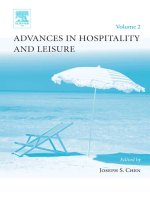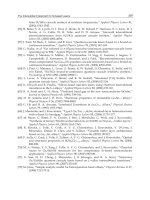ADVANCES IN HOSPITALITY AND LEISURE
Bạn đang xem bản rút gọn của tài liệu. Xem và tải ngay bản đầy đủ của tài liệu tại đây (1.69 MB, 309 trang )
ADVANCES IN HOSPITALITY
AND LEISURE
i
ADVANCES IN HOSPITALITY
AND LEISURE
Series Editor: Joseph S. Chen
Volume 1:
Advances in Hospitality and Leisure,
edited by Joseph Chen
ii
ADVANCES IN HOSPITALITY AND LEISURE VOLUME 2
ADVANCES IN
HOSPITALITY AND
LEISURE
EDITED BY
JOSEPH S. CHEN
Indiana University, Bloomington, USA
Amsterdam – Boston – Heidelberg – London – New York – Oxford
Paris – San Diego – San Francisco – Singapore – Sydney – Tokyo
iii
ELSEVIER B.V.
Radarweg 29
P.O. Box 211
1000 AE Amsterdam,
The Netherlands
ELSEVIER Inc.
525 B Street, Suite 1900
San Diego
CA 92101-4495
USA
ELSEVIER Ltd
The Boulevard, Langford
Lane, Kidlington
Oxford OX5 1GB
UK
ELSEVIER Ltd
84 Theobalds Road
London
WC1X 8RR
UK
r 2006 Elsevier Ltd. All rights reserved.
This work is protected under copyright by Elsevier Ltd, and the following terms and conditions apply to its use:
Photocopying
Single photocopies of single chapters may be made for personal use as allowed by national copyright laws. Permission
of the Publisher and payment of a fee is required for all other photocopying, including multiple or systematic copying,
copying for advertising or promotional purposes, resale, and all forms of document delivery. Special rates are
available for educational institutions that wish to make photocopies for non-profit educational classroom use.
Permissions may be sought directly from Elsevier’s Rights Department in Oxford, UK: phone (+44) 1865 843830, fax
(+44) 1865 853333, e-mail: Requests may also be completed on-line via the Elsevier
homepage ( />In the USA, users may clear permissions and make payments through the Copyright Clearance Center, Inc., 222
Rosewood Drive, Danvers, MA 01923, USA; phone: (+1) (978) 7508400, fax: (+1) (978) 7504744, and in the UK
through the Copyright Licensing Agency Rapid Clearance Service (CLARCS), 90 Tottenham Court Road, London
W1P 0LP, UK; phone: (+44) 20 7631 5555; fax: (+44) 20 7631 5500. Other countries may have a local reprographic
rights agency for payments.
Derivative Works
Tables of contents may be reproduced for internal circulation, but permission of the Publisher is required for external
resale or distribution of such material. Permission of the Publisher is required for all other derivative works, including
compilations and translations.
Electronic Storage or Usage
Permission of the Publisher is required to store or use electronically any material contained in this work, including any
chapter or part of a chapter.
Except as outlined above, no part of this work may be reproduced, stored in a retrieval system or transmitted in any
form or by any means, electronic, mechanical, photocopying, recording or otherwise, without prior written permission
of the Publisher.
Address permissions requests to: Elsevier’s Rights Department, at the fax and e-mail addresses noted above.
Notice
No responsibility is assumed by the Publisher for any injury and/or damage to persons or property as a matter of
products liability, negligence or otherwise, or from any use or operation of any methods, products, instructions or
ideas contained in the material herein. Because of rapid advances in the medical sciences, in particular, independent
verification of diagnoses and drug dosages should be made.
First edition 2006
British Library Cataloguing in Publication Data
A catalogue record is available from the British Library.
ISBN-10: 0-7623-1284-x
ISBN-13: 978-0-7623-1284-9
ISSN:
1745-3542 (Series)
∞ The paper used in this publication meets the requirements of ANSI/NISO Z39.48-1992 (Permanence of Paper).
Printed in The Netherlands.
Working together to grow
libraries in developing countries
www.elsevier.com | www.bookaid.org | www.sabre.org
iv
CONTENTS
LIST OF CONTRIBUTORS
ix
AIMS AND SUBMISSION GUIDELINES
EDITORIAL BOARD
xiii
xv
FULL PAPERS
A COMPARATIVE ANALYSIS OF MULTICULTURAL
INVOLVEMENT IN CULTURE AND ART ACTIVITIES
Sangkwon Lee and Joseph T. O’Leary
THE IMPACT OF TRAINING ON INTERFIRM
DYNAMICS WITHIN A DESTINATION QUALITY
NETWORK: THE CASE OF THE FUCHSIA BRAND,
IRELAND
Megan Woods and Jim Deegan
THE HIDDEN COSTS OF CHEAP GROUP TOURS –
A CASE STUDY OF BUSINESS PRACTICES IN
AUSTRALIA
Bruce Prideaux, Brian King, Larry Dwyer and
Perry Hobson
3
25
51
THEME PARK VISITORS’ DYNAMIC MOTIVATIONS
Hsin-You Chuo and John L. Heywood
73
IMPACTS OF NO-ESCAPE NATURAL DISASTER ON
TOURISM: A CASE STUDY IN TAIWAN
Tzung–Cheng Huan, Chin-Fa Tsai and Lori B. Shelby
91
v
vi
CONTENTS
PREDICTIVE MODEL FOR REPEAT VISITORS TO
SINGAPORE
Hui Tak-Kee and David Wan
107
SWEDISH HOTEL SERVICE QUALITY AND
LOYALTY DIMENSIONS
Peter Schofield and Nicole Katics
123
VALUE RELEVANCE OF EQUITY, EARNINGS AND
CAPITAL STRUCTURE IN THE RESTAURANT
INDUSTRY
Arun Upneja and Nan Hua
159
THE RELATIONSHIP AMONG TRUSTWORTHINESS,
TIME LAPSE, AND ONLINE RESERVATION IN THE
HOSPITALITY AND TOURISM INDUSTRY
´langer and Muzaffer Uysal
David Y. Chang, France Be
179
YOUTH PATRONS’ TRIP PREFERENCES AND
PERCEPTIONS OF ACCOMMODATIONS IN
SWITZERLAND
Colin Johnson, Thouraya Gherissi Labben and
Joseph S. Chen
199
RESEARCH NOTES
TRENDS IN TOURISM ACCOMMODATION
INVESTMENT IN AUSTRALIA
Mainul Haque
215
INTERNATIONAL VISITORS’ PERCEPTIONS OF
OKLAHOMA
Suosheng Wang
239
Contents
vii
THE EFFECTS OF AIRFARES AND FOREIGN
EXCHANGE RATES ON GLOBAL TOURISM
Henry G. Iroegbu
255
CUSTOMERS’ PREFERENCES TO HEALTHY MEALS
Willy Legrand and Philip Sloan
265
AN INVESTIGATION OF PERCEIVED JUSTICES AND
CUSTOMER SATISFACTION
Denver E. Severt
275
SUBJECT INDEX
291
This page intentionally left blank
viii
LIST OF CONTRIBUTORS
´langer
France Be
Department of Accounting and Information
Systems, Virginia Polytechnic Institute and State
University, VA, USA
David Y. Chang
Department of Nutrition and Hospitality
Management, East Carolina University, NC,
USA
Joseph S. Chen
Department of Recreation and Park
Administration, Indiana University at
Bloomington, IN, USA
Hsin-You Chuo
Department of Hospitality Management,
Tunghai University, Taichung, Taiwan
Jim Deegan
National Centre for Tourism Policy Studies,
University of Limerick, Ireland.
Larry Dwyer
School of Economics, University of New South
Wales, Sydney, Australia
Mainul Haque
Tourism Division, Department of Industry,
Tourism and Resources, Canberra City,
Australia
John L. Heywood
School of Natural Resources, The Ohio State
University, OH, USA
Perry Hobson
School of Tourism & Hospitality Management,
Southern Cross University, Lismore, Australia
Nan Hua
The School of Hospitality Management, The
Pennsylvania State University, PA, USA
Tzung-Cheng Huan
College of Management, Graduate Institute of
Leisure Industry Management, National Chia-yi
University, Chia-yi, Taiwan
ix
x
LIST OF CONTRIBUTORS
Henry G. Iroegbu
Hospitality and Tourism Management Program,
School of Business and Public Administration,
University of the District of Columbia, WA,
USA
Colin Johnson
Department of Hospitality Management, San
Jose State University, CA, USA
Nicole Katics
Management and Management Sciences
Research Institute, University of Salford,
Salford, UK
Brian King
Centre for Hospitality, Tourism & Marketing,
Victoria University, Victoria, Australia
Thouraya Gherissi
Labben
`
Lausanne Hospitality Research, Ecole hoteliere
ˆ
`
de Lausanne, Le Chalet-a-Gobet, Lausanne,
Switzerland
Sangkwon Lee
Department of Recreation, Park, and Tourism
Sciences, Texas A&M University, TX, USA
Willy Legrand
Department of Hospitality Management,
International University of Applied Sciences Bad
Honnef. Bonn, Bad Honnef, Germany
Joseph T. O’Leary
Department of Recreation, Park, and Tourism
Sciences, Texas A&M University, TX, USA
Bruce Prideaux
School of Business, James Cook University,
Queensland, Australia
Peter Schofield
Management and Management Sciences
Research Institute, University of Salford,
Salford, UK
Denver E. Severt
Rosen College of Hospitality Management,
University of Central Florida, FL, USA
Lori B. Shelby
Department of Natural Resource Recreation
and Tourism, Colorado State University, CO,
USA
Philip Sloan
Department of Hospitality Management,
International University of Applied Sciences Bad
Honnef. Bonn, Bad Honnef, Germany
xi
List of Contributors
Hui Tak-Kee
Department of Decision Sciences, NUS Business
School, National University of Singapore,
Singapore
Chin-Fa Tsai
Department of Business Administration,
National Chia-yi University, Chia-yi, Taiwan
Arun Upneja
The School of Hospitality Management, The
Pennsylvania State University, PA, USA
Muzaffer Uysal
Department of Hospitality and Tourism
Management, Virginia Polytechnic Institute and
State University, VA, USA
David Wan
Department of Management and Organization,
NUS Business School, National University of
Singapore, Singapore
Suosheng Wang
Department of Tourism, Convention & Event
Management, Indiana University Purdue
University, Indianapolis, USA
Megan Woods
Swiss Hotel Management School, Leysin,
Switzerland
This page intentionally left blank
xii
AIMS AND SUBMISSION GUIDELINES
Advances in Hospitality and Leisure (AHL), a peer-review publication, aims
to promote seminal and innovative research outputs pertaining to hospitality, leisure, tourism, and lifestyle. Specifically, the series will encourage
researchers to investigate new research issues and problems that are critical
but have been largely ignored while providing a forum that will disseminate
singular thoughts advancing empirical undertakings both theoretically and
methodologically.
The issue includes the articles on critical literature review that discuss the
shortcomings of past research and provide the guidance for future research
agendas in relation to hospitality, leisure, and tourism issues. In addition,
empirical papers with a new investigative theme are included. In total the
issue contains 10 full papers and 5 research notes.
For submission to future issues, please review the following guidelines.
Originality of Manuscript: The manuscript should represent an original
work that has never been published elsewhere nor is being considering for
publication elsewhere.
Style and Length of Manuscript: 12 pt Times Roman font; double spacing;
APA; 7,000 words (Full Paper) or 4,000 words (Research Note).
Layout of Manuscript: First page: title of paper and author information;
second page: title of paper, 100–120 word abstract, and keywords; third
page and beyond: main text, appendix, references, figures, and tables.
Text of Manuscript: For literature review articles, please include introduction, critical literature review, problems in past research, and suggestions for
future research. For empirical research papers, please include introduction,
methods, findings and discussions, and conclusion.
AHL requires electronic submission. Please use an email attachment with
Microsoft Word format to the editor Dr. Joseph Chen (joechen@indiana.
edu) or send a diskette to Tourism Management Program, HPER Building
#133, Indiana University, Bloomington, Indiana 47405, USA.
xiii
This page intentionally left blank
xiv
EDITORIAL BOARD
Editor-in-Chief
Joseph S. Chen
Indiana University (Bloomington), USA
Editorial Review Board
North America
Rachel Chen
University of Tennessee, USA
Dogen Gursoy
Washington State University, USA
Colin Johnson
San Jose State University, USA
Anna Mattila
Pennsylvania State University, USA
William Norman
Clemson University, USA
Haemoon Oh
Iowa State University, USA
H.G. Parsa
Ohio State University, USA
John Williams
University of New Orleans, USA
Yuksel Ekinci
University of Surrey, UK
Metin Kozak
Mugla University, Turkey
´de
Fre ´ric Dimanche
European School of Business,
France
Marianna Sigala
University of Aegean,
Greece
Helmut Wachowiak
Intl. U. of Applied Sciences,
Bad Honnef, Germany
Asia/Pacific
Tzung-Cheng Huan
National Chia-Yi University,
Taiwan ROC
Tak-Kee Hui
National University of Singapore,
Singapore
Bruce Prideaux
James Cook University,
Australia
Europe
Marcjanna Augustyn
University of Hull, UK
David Botterill
University of Wales Institute
(Cardiff), UK
xv
This page intentionally left blank
xvi
FULL PAPERS
1
This page intentionally left blank
2
A COMPARATIVE ANALYSIS OF
MULTICULTURAL INVOLVEMENT
IN CULTURE AND ART ACTIVITIES
Sangkwon Lee and Joseph T. O’Leary
ABSTRACT
The purpose of this research is to examine the characteristics and participation patterns in culture and art activities by multicultural groups
through comparative examination using logistic regression analysis. Regarding the differences of participation patterns of cultural activities, the
results show that there are meaningful changes of participation patterns
by race. Income level seems to have dissipated as a barrier in attending
cultural activities. In contrast, there is a meaningful change in the relationship between educational attainment and attendance in cultural activities. There are differences in art exhibition attendance by race. Income
and educational attainment are also closely related to art exhibition
attendance. The results of the analysis imply that it is necessary to segment the consumers of culture and art events specifically by race, income
level, or educational attainment.
Advances in Hospitality and Leisure, Volume 2, 3–24
Copyright r 2006 by Elsevier Ltd.
All rights of reproduction in any form reserved
ISSN: 1745-3542/doi:10.1016/S1745-3542(05)02001-1
3
4
SANGKWON LEE AND JOSEPH T. O’LEARY
INTRODUCTION
It is imperative to recognize the meaning and significance of race and ethnicity in the US society where everyday life activities are becoming increasingly more impacted by ethnic and racial diversity (Hutchison, 2000). The
population of Hispanics has already surpassed that of African Americans.
The structure of race in the US is changing dramatically and diversity issues
are one of the major issues in understanding the current American society.
Therefore, more specific studies to help understand the relationship between
multicultural groups and their participation patterns in cultural activities are
needed. Most previous studies have assumed that the ethnic and racial
groups will have different behaviors, preferences, or beliefs from the dominant white population. However, there have been only limited studies which
have discovered systematic differences among groups (Hutchison, 2000).
A problem with conceptualizing the origins of the differential participation patterns among people of diverse cultural background is that, much of
the cross-cultural research in leisure activity participation in the literature
has tended to be concentrated in outdoor recreation, to the detriment of
other areas. The realm of the ‘expressive aspects of culture’ (composed of
the arts and entertainment), where minority populations tend to seek leisure
diversion in greater numbers (Chick, 1998), tends to get less attention in
such research. Even when research studies examine the relationship between
cultural identity and cultural leisure activities, relatively few tend to focus on
the arts (Filicko, 1996). Consequently, research that compares participation
in the arts among people of different cultural backgrounds is not very
common. With the changes taking place in the population because of the
growth in certain racial and ethnic groups, understanding the patterns of
involvement is critical for tourism planning, management, marketing, and
product development.
The purpose of this research is to examine the characteristics and participation patterns in culture and art activities by ethnic groups and socioeconomic status through a comparative analysis in 1982, 1992, and 1997
using the Survey of Public Participation in the Arts (SPPA) sponsored by
the National Endowment for the Arts (NEA). While individual surveys have
been examined (NEA report #70, 1998; NEA report #71, 1999; NEA report
#72, 1999; Schuster, 2000), there has been no research done comparing these
surveys to look at changes from 1982 to 1997. These comparisons will provide meaningful new results and contribute to understanding societal diversity. In addition, by approaching consumer segmentation by race, this
research will also provide useful information to event and festival managers
A Comparative Analysis of Multicultural Involvement
5
at the various government levels in establishing festival planning and
marketing. Owing to the sample, this study mainly will focus on the differences between whites and blacks.
LITERATURE REVIEW
Festivals and cultural activities are part of a thriving economic industry that
continues to grow both domestically and internationally. Approximately 81
percent of US adults traveled to historic sites or to participate in arts and
cultural activities in 2002 (Travel Industry Association of America, 2003). In
this section, we summarize a variety of theories surrounding race issues and
participation in culture and art activities. The relationship between race,
class, and leisure behavior has long been a constant subject of interest for
social scientists, and over the past 30 years, leisure scholars have produced a
substantial amount of literature around the dynamics of race and ethnicity
in leisure studies (Floyd, 1998). Many existing studies have focused on differences in whites and blacks (Hutchison, 2000). While research on the
black–white differences has yet to produce any conclusive or cumulative
results, much of the earlier race and ethnic literature developed around the
marginality and ethnicity hypotheses.
Marginality and Ethnicity
The marginality and ethnicity hypotheses have been the two theoretical
explanations that explicate the racial and ethnic variation in empirical
leisure research (Hutchison, 1988; Floyd & Gramann, 1993; Bowker &
Leeworthy, 1998). Researchers remain divided as to whether observed differences are due to race (Washburne, 1978), social class (Kelly, 1980), or to
the combined factors of race and social class (Edwards, 1981). Dwyer and
Hutchison (1990) examine participation differences between blacks and
whites in an attempt to determine whether the differences were because of
black ethnicity or class factors. The authors find that there is only a weak
relationship between race and participation. The two perspectives, question
whether differences in participation are due to the cultural characteristics of
particular minority groups or to the social position they occupy in the
dominant society (Hutchison, 1988). The marginality view suggests that
black participation patterns result from limited socioeconomic resources,
emphasizing minority social status in white majority society (Floyd, 1998;
6
SANGKWON LEE AND JOSEPH T. O’LEARY
Floyd, McGuire, Shinew, & Noe, 1994). Therefore, the marginality view
suggests that differences in participation of recreational activities may be
explained by differential access to recreation resources due to the income,
occupation, and the inequitable distribution of recreation facilities and other
public goods. Washburne (1978) argues that blacks have only limited access
to leisure due to poverty and discrimination, and describes that the generally
marginal position of blacks in society could have resulted in a lifestyle
constrained by unmet needs and limited opportunities due to their social
environment. In addition, Wilson (1980) suggests that social class is a more
important determinant of economic and social opportunity than race.
Alternatively, the ethnicity hypothesis suggests that regardless of socioeconomic standing, cultural processes are more important in influencing
minority under-participation or variation between the two races. The ethnicity view explains differences in participation as reflecting divergent
norms, value systems, and social organization between majority and
minority populations (Floyd, 1998). According to Hutchison (1988), the
ethnicity perspective is a cultural explanation that highlights leisure as an
integral reflection of culture to explain the intergroup differences. These
theoretical positions are important since they suggest different policies for
meeting the needs of ethnic or racial groups. The fundamental problems for
race and ethnicity research are the lack of theoretical and conceptual development and over reliance on the marginality and ethnicity hypotheses
(Floyd, 1998). Some studies argue that the reason for the differences between ethnic groups might be more complex than just marginality and
ethnicity. DiMaggio and Ostrower (1990) suggest the differences in art participation might come from economic status, familiarity, and even some
discrimination and segregated networks. They find differences in arts participation between black and white Americans based on a cultural participation theory. Additionally, Shinew, Floyd, McGuire, and Noe (1995)
suggest that there is class polarization among African Americans. Blacks
within higher social classes might benefit from affirmative action and other
programs, and have similar lifestyles and behaviors to white counterparts.
On the other hand, poor blacks might become more differentiated from the
higher classes of blacks. Gobster (1998) identifies some important themes
relating to explanations for under-participation, including awareness and
knowledge, marginality and opportunity, ethnicity and preference, and perceived discrimination and comfort. Floyd and Shinew (1999) suggest that
the similarity of leisure preference between blacks and whites might be
caused by their interracial contact, regardless of their socioeconomic background.
A Comparative Analysis of Multicultural Involvement
7
Convergence or Ethnic Assimilation
Yinger (1981) defines ethnic assimilation as a process of boundary reduction
that can occur when members of two or more societies or of smaller cultural
groups meet (Floyd & Gramann, 1993). Functionalist theories predict that
ethnic cultural differences are eroded by modernization and intergroup contact and reduction of particularistic barriers (DiMaggio & Ostrower, 1990).
It is assumed that interracial contact and increased interracial social interaction will increase the probability that, different ethnic groups will have a
similar mode of life and access to cultural capital. Thus, greater similarity or
convergence is expected among different ethnic groups (Floyd, 1999).
Structural Assimilation and Acculturation
Structural assimilation refers to the entry of a minority group into the social
institutions of the majority, including the economic affordability, education,
civic affairs, and government (Floyd & Gramann, 1993). Robert Park and
the Chicago School suggest that differences between ethnic groups and the
dominant (white) culture will disappear as these groups are assimilated into
mainstream culture (Hutchison, 2000). That is, with the policy implication
and cultural influence, the ethnic or racial minorities should behave the same
as the dominant group (white). Floyd and Shinew (1999) find African
Americans who with high interracial contact with whites had more similar
leisure preferences with their white counterparts than with other blacks. The
differences among race participation in cultural art events are due to differences in participants’ competencies and to differences with respect to their
social status position. The social status of participants in cultural events is
related to the prestige of the activities (DiMaggio & Useem, 1978).
Acculturation is one dimension of ethnic assimilation. Acculturation assumes that an ethnic population may adapt and change some aspects of the
dominant culture while rejecting others. The minority group only acquires
cultural characteristics of the dominant group such as language, diet, and
religion. Recent theoretical and empirical studies have challenged the assimilation perspective (Floyd, 1998). According to Hutchison (2000), the
references to assimilation were replaced with acculturation more than two
decades ago. Besides, the acculturation perspective had only been used in
the studies of Hispanics (Floyd, 1998). It is not clear whether or how the
assimilation or acculturation perspective applies to African Americans or
other ethnic groups (Floyd, 1998; Hutchison, 2000).
8
SANGKWON LEE AND JOSEPH T. O’LEARY
Participation in Leisure Activities
With inter-group competitions, ethnic mobilization increases, minority economic advances, and institutional discrimination, assimilation will be prevented and the minority will maintain a distinctive unifying culture
(DiMaggio & Ostrower, 1990). Woodard (1988) argues that social class is
an effective determinant of participation in urban-oriented leisure such as
visiting museums or libraries. McGuire, O’Leary, Alexander, and Dottavio
(1987) compare the leisure preferences and constraints between senior white
and black people. Their study indicates more similarities than differences in
outdoor recreation preferences between different ethnic groups. Blacks preferred attending sporting events, picnicking and traveling, while whites
preferred walking and other outdoor activities. In a study examining a correlation of participation pattern of blacks and whites, Stamps and Stamps
(1985) find that there is greater similarity in leisure activities in the same race
than among those of a similar social class. Hutchison (1988) points out that
the differences between blacks and whites would not be explained by the
simple influence of either social class or race, but by a more complex interaction between these two factors. Shinew et al. (1995) also find that the
preference of leisure was influenced by an interaction of gender, race, and
subjective social class. In addition, Johnson, Bowker, English, and Worthen
(1998) examine the ethnicity and marginality theory of minority recreation
participation by examining the differences in rural African Americans and
whites visitation rates to national forest wildland areas. The authors test for
black and white differences using logistic regression and the findings show
that race, sex, age, and a race poverty interaction term are strong predictors
of visitation. Overall, the results do not strongly support either ethnicity or
marginality as a sole explanation of racial differences in recreation. Rather,
they indicate that the two probably work in combination to explicate racial
differences.
DiMaggio and Ostrower (1990) examine black and white patterns of arts
participation. The authors find that black Americans in the arts participate
at rates and in ways that are remarkably similar to that of white Americans,
considering the degree of racial exclusion and oppression they have been
subjected to. However, the effects of race on these activities are diminished
by effects of educational attainment, and often less than those of income,
gender, or place of residence. Thus, the authors conclude that the relationship between race and taste is differentiation without segmentation, meaning differing tastes, but not segregated or strongly bounded by subculture.
The authors also argue that existing findings are intriguing but inconclusive,









